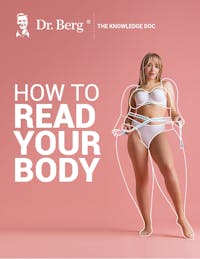Premenstrual Dysphoric Disorder (PMDD)

How to Read Your Body
Learn to recognize common symptoms and uncover their underlying health issues
Understand the signs of nutrient deficiencies to manage your health
Explore the four metabolic body types and the core factors that influence them
Interpret your body's signals from head to toe to identify potential health concerns

How to Read Your Body
Learn to recognize common symptoms and uncover their underlying health issues
Understand the signs of nutrient deficiencies to manage your health
Explore the four metabolic body types and the core factors that influence them
Interpret your body's signals from head to toe to identify potential health concerns

How to Read Your Body
Learn to recognize common symptoms and uncover their underlying health issues
Understand the signs of nutrient deficiencies to manage your health
Explore the four metabolic body types and the core factors that influence them
Interpret your body's signals from head to toe to identify potential health concerns

How to Read Your Body
Learn to recognize common symptoms and uncover their underlying health issues
Understand the signs of nutrient deficiencies to manage your health
Explore the four metabolic body types and the core factors that influence them
Interpret your body's signals from head to toe to identify potential health concerns

How to Read Your Body
Learn to recognize common symptoms and uncover their underlying health issues
Understand the signs of nutrient deficiencies to manage your health
Explore the four metabolic body types and the core factors that influence them
Interpret your body's signals from head to toe to identify potential health concerns

How to Read Your Body
Learn to recognize common symptoms and uncover their underlying health issues
Understand the signs of nutrient deficiencies to manage your health
Explore the four metabolic body types and the core factors that influence them
Interpret your body's signals from head to toe to identify potential health concerns

How to Read Your Body
Learn to recognize common symptoms and uncover their underlying health issues
Understand the signs of nutrient deficiencies to manage your health
Explore the four metabolic body types and the core factors that influence them
Interpret your body's signals from head to toe to identify potential health concerns

How to Read Your Body
Learn to recognize common symptoms and uncover their underlying health issues
Understand the signs of nutrient deficiencies to manage your health
Explore the four metabolic body types and the core factors that influence them
Interpret your body's signals from head to toe to identify potential health concerns

Easy Keto and Intermittent Fasting
Discover the fundamentals of Healthy Keto® and intermittent fasting
Understand the unique benefits of combining keto and intermittent fasting
Explore what foods to include and avoid on a Healthy Keto diet
Receive practical advice on common pitfalls and how to overcome them
Get a selection of easy-to-make and nutritious recipes to get you started

Easy Keto and Intermittent Fasting
Discover the fundamentals of Healthy Keto® and intermittent fasting
Understand the unique benefits of combining keto and intermittent fasting
Explore what foods to include and avoid on a Healthy Keto diet
Receive practical advice on common pitfalls and how to overcome them
Get a selection of easy-to-make and nutritious recipes to get you started

Easy Keto and Intermittent Fasting
Discover the fundamentals of Healthy Keto® and intermittent fasting
Understand the unique benefits of combining keto and intermittent fasting
Explore what foods to include and avoid on a Healthy Keto diet
Receive practical advice on common pitfalls and how to overcome them
Get a selection of easy-to-make and nutritious recipes to get you started

Easy Keto and Intermittent Fasting
Discover the fundamentals of Healthy Keto® and intermittent fasting
Understand the unique benefits of combining keto and intermittent fasting
Explore what foods to include and avoid on a Healthy Keto diet
Receive practical advice on common pitfalls and how to overcome them
Get a selection of easy-to-make and nutritious recipes to get you started

Easy Keto and Intermittent Fasting
Discover the fundamentals of Healthy Keto® and intermittent fasting
Understand the unique benefits of combining keto and intermittent fasting
Explore what foods to include and avoid on a Healthy Keto diet
Receive practical advice on common pitfalls and how to overcome them
Get a selection of easy-to-make and nutritious recipes to get you started

Easy Keto and Intermittent Fasting
Discover the fundamentals of Healthy Keto® and intermittent fasting
Understand the unique benefits of combining keto and intermittent fasting
Explore what foods to include and avoid on a Healthy Keto diet
Receive practical advice on common pitfalls and how to overcome them
Get a selection of easy-to-make and nutritious recipes to get you started

Easy Keto and Intermittent Fasting
Discover the fundamentals of Healthy Keto® and intermittent fasting
Understand the unique benefits of combining keto and intermittent fasting
Explore what foods to include and avoid on a Healthy Keto diet
Receive practical advice on common pitfalls and how to overcome them
Get a selection of easy-to-make and nutritious recipes to get you started
Premenstrual Dysphoric Disorder (PMDD), is an intense form of PMS that's as unpredictable as it is disruptive.
Learn about PMDD, how hormonal balances affect your well-being, and what you can do to prevent these symptoms.
Understanding PMDD and Its Symptoms
Premenstrual Dysphoric Disorder (PMDD) is a severe form of Premenstrual Syndrome (PMS). Unlike PMS, which many women experience, PMDD affects fewer than 10% of menstruating women.
The main symptoms of PMDD include extreme mood swings that can disrupt work or relationships, intense anger or conflict with other people, feelings of despair, or even suicidal thoughts.
Physical symptoms, including bloating and breast soreness, are regularly experienced by those with PMDD.
This condition often gets brushed off as 'just PMS,' but it's much more severe. Imagine feeling on an emotional rollercoaster for up to two weeks every month.
That’s why understanding these symptoms is crucial for diagnosis and treatment options.
About 5-8% percent of women suffer from this disorder globally.
Symptoms typically start in the late luteal phase (the week before your period starts).

The Role of Hormonal Imbalance in PMDD
Hormonal imbalances are often associated with PMDD (Premenstrual Dysphoric Disorder). But how does this work exactly?
The Impact of Low Progesterone Levels
Hormones are like the body's internal messaging system - they tell your cells what to do and when. Imagine if those messages started getting mixed up. That's kind of what happens with low progesterone levels.
A decrease in progesterone can disturb the equilibrium between estrogen and progesterone, potentially resulting in an excess of estrogen (also known as 'estrogen dominance'), which plays a significant role in PMDD symptoms.
This disruption may cause a lot of estrogen, also known as 'estrogen dominance,' contributing significantly to PMDD symptoms.
This imbalance isn't just a minor annoyance that occurs occasionally; it can cause intense physical and emotional suffering, drastically reducing the quality of life. So, it's essential to understand and manage these hormonal shifts.
Dietary Factors Influencing PMDD
The dietary factors influencing PMDD are crucial, and what you eat can make a difference. Certain foods may disrupt hormonal balance, exacerbating symptoms.
Dairy and Hormone Disruption
Dairy products are a key culprit. Studies show that dairy consumption can mess with hormone levels. This is because dairy contains hormones like estrogen and progesterone, which can destroy your body's natural equilibrium.
This imbalance often leads to excess estrogen, a condition known as estrogen dominance. Estrogen dominance has been linked directly to more severe PMDD symptoms.
To avoid these pitfalls, consider reducing or even eliminating dairy from your meals. There are plenty of delicious alternatives available.
Remember, each person's response to dietary changes will vary, so monitor how you feel when making any modifications. Almond milk is an excellent substitute.
Natural Remedies for Managing PMDD
A diet rich in certain natural foods may offer some relief from PMDD. Two such foods that stand out are cruciferous vegetables and sea kelp.

The Role of Cruciferous Vegetables in Regulating Estrogen Levels
Cruciferous vegetables like broccoli, kale, and cauliflower are rich in phytoestrogens that can help regulate estrogen levels.
These plant-based compounds can help regulate estrogen levels. Studies suggest a correlation between consuming these vegetables and alleviating PMDD symptoms due to their potential effect on hormonal balance.
Beyond just regulating hormones, they also deliver other health benefits. They're loaded with fiber, vitamins C and K, and several minerals.
Sea Kelp for Estrogen Balance
Sea kelp is another dietary superhero against PMDD. It's packed full of iodine, which can help regulate estrogen imbalances, potentially managing the PMDD.
Sea kelp offers additional perks like promoting thyroid health, which further supports hormone regulation. Incorporating these two powerful food items into your meals could be a game-changer in dealing with this condition.
Supplements for Alleviating PMDD Symptoms
Finding relief from PMDD symptoms can feel like a wild goose chase. But don't despair; supplements might be the hidden treasure you're after.
DIM Supplements for Hormone Regulation
DIM (Diindolylmethane) is a concentrated phytonutrient found in cruciferous vegetables that helps regulate hormones.
Taking DIM as a supplement can help fix hormonal imbalances associated with PMDD.
High-Dose Vitamin D for PMDD Relief
When we soak up sunlight, our body produces vitamin D. Many people are deficient in this essential nutrient and could benefit from high-dose supplementation.
Vitamin D doses between 10,000-20,000 IUs have shown promise in reducing PMDD symptoms.
Vitamins and PMDD
Understanding the role of vitamins in managing PMDD (Premenstrual Dysphoric Disorder) is essential for those seeking relief from its symptoms. Vitamin D3, K2, and magnesium benefits can be significant contributors to alleviating the discomfort associated with PMDD.
Vitamin D3, often referred to as the "sunshine vitamin," plays a vital role in mood regulation and can help mitigate the emotional symptoms of PMDD. Additionally, vitamin K2 aids in proper calcium metabolism, potentially reducing some PMDD-related symptoms linked to calcium imbalances.
Magnesium, on the other hand, is known for its muscle-relaxing properties and its ability to alleviate menstrual cramps and other physical discomforts.
By incorporating these vitamins into your diet or through supplementation, you may find relief from PMDD symptoms and experience improved overall well-being during your menstrual cycle.
Conclusion
Premenstrual Dysphoric Disorder (PMDD) poses significant challenges due to its severe and disruptive symptoms. Understanding the hormonal imbalances underlying PMDD is crucial, with low progesterone levels and estrogen dominance playing key roles.
Dietary adjustments, such as reducing dairy intake and incorporating cruciferous vegetables and sea kelp, can help rebalance hormones and alleviate symptoms.
Additionally, supplements like DIM and high-dose vitamin D have shown promise in regulating hormones and easing PMDD symptoms.
Consulting with a healthcare provider for personalized guidance is recommended for developing an effective treatment plan.
By addressing hormonal imbalances through dietary changes and supplementation, individuals can take proactive steps to manage PMDD and improve overall well-being during the menstrual cycle.
Supporting Data
Tags

Popular
08/21/2024
46.7K views
05/22/2024
41K views
11/18/2024
243K views
03/18/2024
11/21/2022




